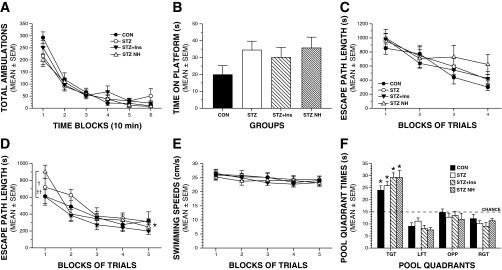Fig. 4.

Severe hypoglycemia does not produce impairment in behavioral and cognitive functions. A: there were no significant effects involving treatment (severe hypoglycemia) on general activity, as measured by total ambulations (whole body movements) during a 1-h locomotor activity test. B: although the CON group tended to perform not as well as the diabetic groups in terms of being able to remain on a small elevated platform, there were no significant differences among groups on this sensorimotor test. C: groups did not differ in escape path length during the cued (visible platform location) trials. D: a repeated-measures ANOVA conducted on the path length data during the place (spatial learning) trials yielded a significant group (treatment) by blocks of trials interaction (*P = 0.011). This was due mostly to increased path length in the STZ-NH group vs. the STZ + Ins (†P = 0.036) or the CON (††P = 0.0369) groups during the first block of trials only, but not thereafter. E: no differences among groups were observed in swimming speeds during the place trials. F: groups performed similarly in terms of time in the target quadrant (TGT) during probe trial 1 (mid-acquisition). In addition, all groups demonstrated significant spatial bias for the TGT that had contained the hidden platform, as evidenced by each group spending significantly more time in the TGT compared with times spent in each of the other quadrants (*P < 0.01). LFT, left quadrant; OPP, opposite quadrant; RGT, right quadrant.
